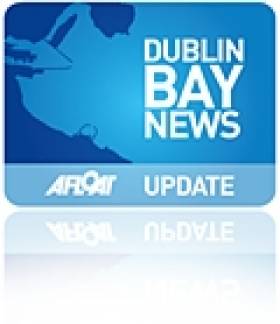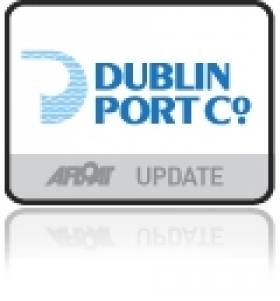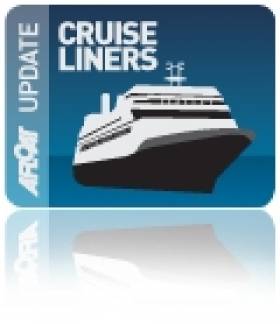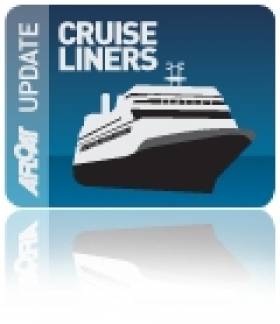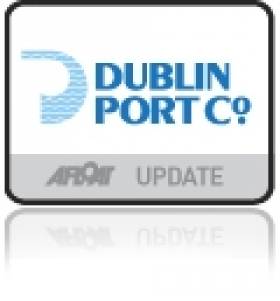Displaying items by tag: Dublin Port
Old Maps Show A Very Different Dublin Bay Before The Walls
#DublinBay - Dublin Bay was we know it today looked very different three centuries ago, as TheJournal.ie highlights with a selection of enlightening historical maps.
As reported yesterday on Afloat.ie, this week marks the 300th anniversary of the decision to build the Great South Wall in an effort to solve the centuries-old problem of silting in the main channels to Dublin Port.
At that time, the area north of Townsend Street that today is the south Docklands did not exist, as the Liffey flowed right up to what was then called Lazar's Hill or Lazy Hill – while Ringsend was a sandpit that extended into the bay at the river's mouth.
The wall changed all that, as the land between was reclaimed and the Liffey's course straightened and strengthened over the 80 years of its construction.
Later change came to the Northside, too, with the construction of the Bull Wall – surveyed by Captain Bligh of 'Mutiny on the Bounty' infamy – as Marino, Fairview and the North Strand, so named for their then coastal locations, lost their sea views to land reclamation, and Bull Island was formed from the sand and silt that once claimed any number of ships on approach to the city.
The maps have been shared by the Dublin Port Company to coincide with the Dublin Bay Conference that takes place today (Wednesday 29 April) with a programme of lectures lined up to celebrate the construction of what was then the longest sea wall in the world.
The Great South Wall: 300 Years Since Idea First Hatched
#DublinPort - Three hundred years ago this week, the decision was made by the Dublin City Assembly to build an embankment from Ringsend into Dublin Bay, in an effort to solve the centuries-old problem of silting in the main channels into Dublin Port.
As RTÉ reports, Philip Bromwell has commemorated this historic occasion with a special multimedia report on the engineering feat, which today extends some 4km to the Poolbeg Lighthouse.
When completed 80 years after plans were first announced, the Great South Wall was the longest sea wall in the world.
And it's still a vital part of the city's infrastructure, helping – along with its sister Bull Wall on the north side of the bay – to keep the port's waters clear of silt and sand build-up for shipping traffic.
But it's also a popular recreation spot for walkers, cyclists, anglers and anyone looking to take in the spectacular vistas of the bay in the shadow of the iconic Poolbeg chimneys.
Get the whole story on the Great South Wall's 300th anniversary HERE.
#PortNews - The International Association of Port Cities (AIVP) will host its AGM for 2015 in Dublin next month ahead of the June Bank Holiday weekend.
'Working Waterfront' is the topic of the two-day meeting which begins with a general assembly at Dublin Castle on Thursday 28 May. Full details of the programme are available HERE.
"Few in number, and in high demand, waterfronts today are becoming strong identifying elements in port cities which are open to the world," according to the organisers, who identify such dynamic areas as 'city-port mixing in progress'.
Panels on the day will discuss city waterfronts as spaces geared towards the maritime economy, cultural activities and more.
They will be followed on Friday 29 May by a tour of Dublin's Docklands and Dublin Port to examine the Irish capital's particular challenges in regenerating its port and reintegrating it as part of the city.
And attendees will be free to enjoy the festivities of the Dublin Port Riverfest, which begins on Saturday 30 May running till Monday 1 June.
Now in its third year, visitors to North Wall Quay over the weekend should expect a "unique celebration" with "a jam packed programme of entertainment and family fun".
Not least among the events planned for the three-day celebration on the Liffey is the arrival of three tall ships and four schooners that will berth at North Wall Quay for the duration.
More details of the maritime festival programme will be available as the weekend draws near.
Dublin Port Shows Off Cruise–Liner Plans at Miami Exhibition
#dublinport – Dublin Port took the opportunity to display a computer-generated image of what the East link bridge area of Dublin might look like at high water with a large cruise liner in the proposed berth when it attended the recent cruise–liner show in Miami, Florida.
Looking eastwards down the river Liffey, the artist's impression shows off the port company's plans for cruise liner berthing as previously reported by Afloat.ie last March. Dublin Port Company plan to redevelop the Alexandra Basin to include two berths for cruise ships of up to 340m in length which will accommodate ships that are significantly larger than the current maximum length of 300m.
Similar berthing plans for the massive ships are also underway across the bay in the south Dublin port of Dun Laoghaire.
The global cruise industry's premier annual international conference and exhibition in Miami drew more than 11,000 attendees and nearly 900 exhibiting companies from over 125 countries.
Dublin Port exhibited as part of 'Cruise Ireland', the island's association of Ports, Shore Excursions Operators, Tourism Organisations, City Councils who share the common objective of making the island of Ireland and all it's charms more accessible for the international Cruise Markets.
The computer-generated image is by New York based architecture firm Bermello Ajamil, whose projects include 'The World in Dubai', one of the most innovative land reclamation and development projects ever attempted.
Cruise Ireland was formed in 1998 after a few tentative years of individual Ports and regions successfully attracting cruise ships. Today the Ports of Ireland play host to some 300 cruise visits each year which is testament to the efforts made by the members of Cruise Ireland.
Each year the members bring improved facilities, unique tours and excellent service to the Cruise industry and the cruise guests who choose to visit.
Dublin Port Cargo Volumes Rise 5.3% in Q1
#cargodublin – Dublin Port Company today published trade statistics for the first quarter of 2015. The figures show continued growth in import and export trade at Ireland's largest port with cargo volumes up 5.3% on the same period last year. This is the strongest first quarter Dublin Port has had in a decade and surpasses the previous record year of 2007 by 3.0%.
Total throughput (imports and exports) for Q1 2015 was 7.8 million gross tonnes, an increase of 5.3% on the 7.4 million tonnes handled in the first quarter last year. There were 1,642 ship arrivals in the first three months. Imports were particularly strong in Q1 at 4.7 million gross tonnes, while exports reached 3.1 million gross tonnes, up 6.9% and 3.0% respectively on Q1 2014 trade levels.
The overall strong growth was driven by a combination of increased movements of unitised goods (containers and trailers) and by imports of petroleum products. Whereas the recovery in Dublin Port's volumes has been export led in recent years, in more recent times there has also been strong growth on the import side as the domestic economy improves. The 8.5% increase in petroleum imports is particularly striking.

Imports of new cars and commercial vehicles continued to grow very strongly with almost 33,000 (32,917) new vehicles imported through Dublin Port in the first three months of the year, up 38.8% on the same period last year. With more people purchasing and registering new vehicles, Dublin Port is well placed to accommodate this increase having opened a new €3.4m 4.2 hectare trade car terminal last year as part of the port's Masterplan 2012 to 2040. Located on East Wall Road, the new trade car terminal can handle 2,500 vehicles at a time.
Unitised trade grew strongly in both the Ro-Ro and Lo-Lo modes. Compared to the same period last year, Ro-Ro trailers moved ahead by 7.2% to 207,042 and the port's Lo-Lo container business increased by 7.3% to 146,156 TEU.
The continued growth in unitised business reaffirms Dublin Port as the island's port of choice for both Ro-Ro and Lo-Lo services. Ro-Ro is Dublin Port's biggest mode and the large growth in Ro-Ro has been driven by increased sailings to both Britain and Continental Europe. There are now 12 daily sailings for passengers and 14 daily sailings for freight to Britain plus five weekly Ro-Ro sailings to Continental Europe.
On the tourism side, Dublin Port attracted 277,269 ferry passengers in the first three months of the year, a 5.0% increase on the first quarter of last year. Dublin Port expects continued growth following Stena Line's recent consolidation of its ferry services into Dublin Port and its introduction of a new ship (Stena Superfast X) on the Dublin to Holyhead route.
Eamonn O'Reilly, Chief Executive, Dublin Port Company, said: "Dublin Port's latest trade figures continue the positive trends of recent years. Our volume grew by 5.3% in the first quarter of 2015. This follows growth of 7.0% in 2014 and 3.0% in 2013, putting Dublin Port back on our Masterplan's growth trajectory which will see volumes double over the period from 2010 to 2040.
"Dublin is the chosen route for imports and exports because of our direct access to most of Ireland's population and frequent shipping services to Ireland's markets in Britain, Continental Europe and beyond. Ferry passengers benefit from a choice of operators and frequent services to and from Dublin Port, bringing them into the heart of the city and with immediate access to the M50 and the country's motorway network.
"We are expanding the capacity of Dublin Port to cater for future growth with a focus on working within the existing footprint of the port and maximising the use of existing port lands. Our plans include the lengthening and deepening of the port's berths and shipping channel and the redevelopment of existing lands for more intensive cargo handling.
"Our current plans are centred on the Alexandra Basin Redevelopment Project which we hope to commence during 2015. In addition to providing additional capacity for cargo, this project will allow us to bring the world's largest cruise ships right up to the East Link Bridge."
Dun Laoghaire Harbour Company Unveils Cruise Berth Plans
#dlharbour – Dun Laoghaire Harbour Company has unveiled a proposed €18m plan to facilitate some of the world's biggest cruise liners inside the harbour walls. A Public consultation will open on the plans for the new cruise berth facility next Monday.
The ambitious new plan is to regenerate the harbour following the loss of the HSS Stena car ferry between Dun laoghaire and Holyhead in February. There is currently no commerical traffic coming in or out of the harbour but a total of 22 cruise ships are expected at the harbour this Summer, bringing up to 100,000 passengers and crew to the east coast port.
The development of the new cruise berth facility is essential to allow to build on the success to date to bring even more vessels and passengers, according to the harbour company, a state owned commerical entity.
The plan will involve the construction of a new quay wall and dredging of the harbour to facilitate ships up to 300 metres in length, (twice the length of the former HSS ferry) which cannot be currently accomodated anywhere else in Ireland other than Cobh in Cork Harbour on the South coast.
The plan is being unveiled this week to harbour and town interest groups including yachts and boat clubs and sailing schools over the course of 20 presentation meetings, according to Afloat.ie sources.
A new 435–metre quay wall be built in the middle of the harbour in front of the east marina breakwater to facilitate cruise ships.
If the plan goes ahead the expected construction period is expected to take 15-18 months. Dredging is expected to be to a depth of 10.5 metres to accoomodate the massive ships.
Members of the public and harbour stakeholders are being invited by the Dun Laoghaire Cruise Stakeholder Group to submit their views on plans for the development.
The two week public consultation process will open next Monday (30.03.2015) and is being launched in advance of an expected planning application to An Board Pleanala for the project. The planning application will be made by Dun Laoghaire Harbour Company on behalf of the Dun Laoghaire Cruise Stakeholder Group.
The cruise industry is an important and growing sector of the tourism market. Cruise ships are getting bigger in size, offering more facilities to passengers, but requiring deeper water and longer berths of accommodate them. Over 50% of new ships currently on order are over 300m in length. At present Cobh is the only port in Ireland that can accommodate these vessels. If facilities are not put in place, Ireland risks losing out on the expanding cruise tourism market.
Under the Planning and Development Acts, the cruise berth facility is regarded as strategic infrastructure and the planning application must therefore be made to An Bord Pleanala. It is expected that a finalised planning application and Environmental Impact Statement will go to An Bord Pleanala the end of April / early May 2015. Responses from the public and stakeholders during the consultation process will be taken into account when finalising the application to An Bord Pleanala. When the final application goes to An Bord Pleanala, observations and submissions may be made by members of the public and certain statutory bodies.
Speaking in relation to the launch of the consultation process, Gerry Dunne, CEO of Dun Laoghaire Harbour Company said: "The Dun Laoghaire Harbour Masterplan, published in 2011, identified the need to develop strategies to ensure the long term future of the harbour, in view of the declining importance of ferry traffic. Development of cruise business was identified as one of the opportunities to be pursued. In addition, Dun Laoghaire is designated as a marine tourism port under the Government's National Ports Policy and the development of the cruise business fits into this framework.
"Dun Laoghaire will have its most successful cruise season ever in 2015, with a total of 22 ships expected, bringing up to 100,000 passengers and crew to the harbour. However the development of the cruise berth facility is essential to allow to build on the success to date and to bring even more vessels and passengers to our town.
"The expansion and development of the cruise business offers significant economic benefits to Dun Laoghaire and the surrounding areas. These would include expenditure by disembarked passenger and crew; payments to tour operators by cruise companies and purchases by cruise ships from local supplies while in harbour.
"This is a hugely exciting project for Dun Laoghaire and the members of the Cruise Stakeholder Group are anxious to hear the views of the public before finalising our application to An Bord Pleanala. Full details of the proposals will be available on the Dun Laoghaire Harbour Website from Monday next at www.dlharbour.ie.
Dublin Bay Port's First Cruise Liner of 2015 Season Calls
#CruiseLiners- Azores became the first cruiseship in 2015 to Dublin Port yesterday out of around 85 calls this season, while a further 22 such ships calling for Dun Laoghaire Harbour, are mostly to anchor offshore, writes Jehan Ashmore.
This year's first seasonal arrival to Dublin Port saw Azores call from the UK while on charter to Cruise & Maritime Voyages. The 550 passenger ship is on a cruise bound for Iceland having departed Avonmouth, (the cruise port for Bristol) from where she had completed a Norwegian fjords cruise.
Both Dublin Bay ports are expecting to follow the success of previous years. Dublin Port in 2014 alone handled over 135,000 passengers and crew visiting the capital city which generated a major economic boost of €50 million. This season the port is to welcome some very large callers, among them Caribbean Princess, Queen Victoria and Norwegian Star.
Dun Laoghaire Harbour is set to achieve significant growth as also previously reported on Afloat.ie, compared to the last four seasons, which started off, with just one-cruiseship, the 48-passenger Quest, but in 2015 there will be a major bumper season totalling 22 callers.
The inaugural caller to Dun Laoghaire will also be the biggest (in passenger capacity) when Splendida calls on May 15th and again on the 21st of that same month. The massive 137,000 tonnes ship operated by MSC Cruises has 3,900 passengers and 1,346 crew is also scheduled to make a third call at the end of August.
The south Dublin Bay port will also welcome notable large-sized anchorage callers, among them the return of Queen Mary 2, albeit a once-off call on 20th May.
Before the Cunard Line 'flagship''s visit, Princess Cruises impressive Royal Princess (see Belfast visit) will make a debut call to Dun Laoghaire. A sister, albeit P&O Cruises 143,000 tonnes Brittania, the largest ever cruisehip built exclusively for the UK market, is to make her first arrival off Dun Laoghaire in July.
The 3,647 passenger capacity and 1,350 crew of Britannia made her maiden call to her homeport of Southampton earlier this month. As mentioned above, the newbuild in July is to make an inaugural UK & Ireland cruise which includes the call to Dun Laoghaire.
If every cruiseship is assumed to have full capacity and all passengers go ashore then Dun Laoghaire can expect some 63,237 tourists over the course of the 2015 season. In addition to all ship's crew numbers this figure would be boosted by over 25,000 bringing potentially 88,282 in total visitors.
The rising boom in the cruise industry and the issue of accomodating increasingly large cruiseships has led to Dublin Port to propose plans to build a dedicated cruise terminal closer the city-centre. At Dun Laoghaire Harbour, there are plans to build a facility, given the demise of Stena HSS operations on the route to Holyhead that closed last year.
#dublinbaynews – Lord Mayor of Dublin Christy Burke today called on walkers of all ages to register for the tenth annual Harbour2Harbour Walk in aid of Aware. The walk, which takes place on St. Patrick's Day, Tuesday 17th March 2015 at 10.30am will help to raise vital funds and awareness for the work of Aware, the national organisation which provides a range of support, education and information services around depression and mental health.
A fun event for an important cause, participants can choose to walk from Dun Laoghaire Harbour to Howth Harbour or vice versa along a 16.2 mile route that takes in the scenic vista of Dublin Bay. Now in its tenth year, the walk has become a hugely popular event with over 870 walkers raising €40,000 in 2014. This year Aware hopes to increase the number of participants to 1,500 and increase funds raised through participation, sponsorship and online donations from the event.
Promising a fun-filled family day out, there will be extra activities and treats along the way too thanks to Dublin Port Company. A charity partner of Aware for the organisation's 30th year, Dublin Port Company is hosting a refreshment station for all participants at Berth 18 (opposite 3 Arena), marking the mid-way point of the walk. Music and refreshments will be in full flow at Dublin Port's 'halfway hoolie' to spur walkers on the next leg of their journey!
Lord Mayor Christy Burke said: "This year's walk promises to be a fantastic day out for a very important cause. Getting out in the fresh air, taking part in exercise and being involved in group activities can all be beneficial when it comes to looking after our mental health and wellbeing, so the Harbour2Harbour Walk is a very fitting event that promises to bring family and friends together this St. Patrick's Day in Dublin."
John Fairley, Land Operations Manager, Dublin Port Company, said: "As Aware's new charity partner, Dublin Port Company is delighted to support this fantastic event. For 30 years Aware has been making a real difference to the lives of so many individuals and families across Ireland. Anyone who has attended the Harbour2Harbour Walk in previous years knows that it is an immensely enjoyable day out and this year promises to be no exception. I'd encourage walkers to sign up and make this St. Patrick's Day a day to remember."
Amo Sayed, Head of Business Development and Fundraising with Aware said: "We're really excited about this year's Harbour2Harbour Walk. Little did anyone think when the event started back in 2005 that it would still be one of Aware's most important Dublin-based fundraisers a decade later! It's a brilliant alternative on the country's national day, and we've had parents with babies in strollers, teenagers, groups of friends or colleagues, and one of our most regular walkers over the years is a man in his eighties. It really is a great day out, and yes the legs will be tired at the end of it but there's nothing like a bracing walk along the spectacular Dublin Bay to blow the cobwebs away."
The deadline for registrations for the Harbour2Harbour Walk is 14th March. Entry €25 per person available now at https://www.eventbrite.ie/e/harbour2harbour-walk-2015-dublin-tickets-15372501566. Participants are also encouraged to take a sponsorship card from Aware and raise further support for the organisation's work.
‘Dublin Ships’ - Public Artwork Display 'LED' Along the Quays
#DublinLEDShips - 'Dublin Ships' is the title given to a temporary public artwork commissioned as part of the Dublin City Public Art Programme that is currently running until July 2015.
The work by Cliona Harmey uses large LED screens located on the Scherzer Bridges at North Wall Quay close to the National Convention Centre.
Dublin Ships artwork is generated from live electronic signals which track the arrivals and departures of each ship in Dublin Port. The name of the ship is then transmitted in real-time to two large LED screens facing towards the city, and remains illuminated in black and white until the next ship either arrives in or leaves the port.
Afloat.'s Ferry News Correspondent, Jehan Ashmore, took recent photos of the LED screens on the bridge with the passing road quayside traffic below. At the time the screens boldly displayed the names of a pair of rival ferries currently operating services on the Dublin-Holyhead route.
The ferries were 'Ulysses' and 'Nordica' and all in LED technical glory! Ulysses is Irish Ferries 'flagship' on the Ireland-Wales link. On the adjoining screen was the 'Nordica', the Stena Line ferry which also operates on the Irish Sea 'central corridor' route.
However, such a display of the Nordica blazed in LED light will diminish to that just representing a visual image of the past!.. As the Stena Nordica (to give her full name) is to be replaced next month by 'Superfast X' as previously reported on Afloat.ie.
As 'Dublin Ships' has clearly demonstrated by bringing to life the movements of ships in Dublin Port. In addition by using this medium to create a strong visual and cultural link between the port and the city in full view of Dublin's citizens, commuters and pedestrians.
The work juxtaposes the speed of instantaneous data with the speed of movement of real entities in space. Dublin Ships highlights the meanings and poetic qualities of ship names, which include allusions to maritime trade, cargoes, historical figures and distant places.
Harmey's work combines sculpture, with live data from transport and communication infrastructure.
Recent work has harvested both open satellite and real-time airline information to create works that engage with notions of time and information space. Her sculptural works are concerned with spatial, broadcast and environmental phenomena (flight data, light, atmospheric pressure).
Dublin Port's Diving Bell To Be Restored As Visitor Centre
#DublinPort - Dublin Port's 140-year-old diving bell is set to be restored as a tourist attraction, as the Irish Independent reports.
The diving bell was first used in construction of the capital's deep-water quays in 1871, allowing for water to be pumped out and air to be pumped in for workers to make the river bed level, acting like a mobile caisson.
It was last used in the building of quayside walls as recently as 1958, and following a campaign to save it from the scrapheap in the 1980s it was moved to its present location on Sir John Rogerson's Quay.
Now it will form the basis of a new interpretive centre to be readied this June, where visitors will be able to access the 90-tonne device from beneath and learn more about its fascinating history.
The Irish Independent has more on the story HERE.
More from Dublin Port Company:
Have you ever passed by the odd looking, bell-shaped, red metal structure standing tall on Sir John Rogerson's Quay and wondered what it is? You could be forgiven for thinking it is a modern art sculpture or misplaced mound of metal. It is in fact an ingenious feat of Irish engineering that was essential in building Dublin's quay walls for 87 years. This is Dublin Port's "Diving Bell".
Dublin Port Company today announced a new project that will shed light on this important artefact and will transform the Diving Bell into a new interpretive exhibition that explains its origin and history.
The Diving Bell was designed by the port engineer Bindon Blood Stoney (1828 to 1907) and built by Grendon and Co., Drogheda. It was delivered to the Port in 1866, entered service in 1871 and was used in the building of the Port's quay walls until 1958. Stoney was a prodigious engineer and among his achievements were the building of the Boyne Viaduct in Drogheda, the construction of O'Connell Bridge and the building of many of the Port's quay walls including Sir John Rogerson's Quay and North Wall Quay Extension.
The Diving Bell was used in the building of the Port's quay walls from the Victorian era right up until almost the 1960s. It was a ground-breaking piece of engineering innovation in its day.
Its lower section was hollow and bottomless, providing just enough room for six men to work at a time. Once lowered into position on the riverbed, the crew entered through an access funnel from the surface and compressed air was fed in from an adjacent barge. The men inside the bell worked on the river bed exposed at their feet, excavating the site where a massive concrete block would later go; all the excavated soil was stashed in trays hanging inside the bell, and brought up when the bell was lifted.
The project, which commences this week and opens in mid-June 2015, will elevate the 13m tall, 90 tonne Diving Bell onto a two metre steel structure, creating a ramped public access route underneath. A water feature will also be installed beneath the structure accompanied by a series of interpretative panels explaining the historical, social and engineering significance of the Diving Bell. The new exhibition will be illuminated at night time using energy efficient LED lighting.
The project has been designed with the expertise of a range of people including the architect Sean O'Laoire, the sculptor Vivienne Roche, Tom Cosgrave (professor of engineering at the University of Limerick) and Mary Mulvihill of Ingenious Ireland.
This is the first project in Dublin Port's plan to create a 'distributed museum' of attractions across the Dublin docklands and into Dublin Port to preserve the port's industrial heritage and history.
Weslin Construction Ltd. has been appointed to carry out the project, which will be completed by mid-June 2015, when the newly reconfigured Diving Bell will open again to the city.
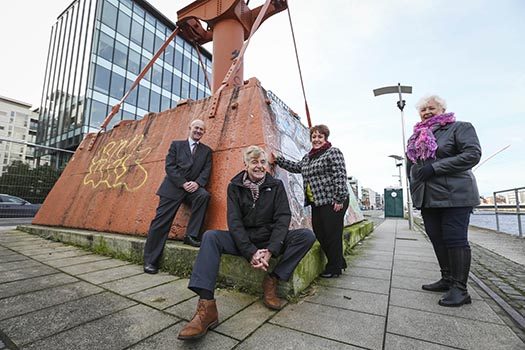
Pictured at the announcement are: Eamonn O'Reilly, Chief Executive, Dublin Port Company, Sean O'Laoire, Director of MOLA Architecture, Dolores Wilson, St. Andrews Resource Centre and Betty Ashe, St. Andrews Resource Centre
Eamonn O'Reilly, Chief Executive, Dublin Port Company said: "The Diving Bell is a remarkable feat of Irish engineering and Dublin Port Company is proud to invest in its transformation and bring the history of this magnificent structure to life along the Liffey. True to the commitment in our Masterplan, we are working to better integrate Dublin Port and the city. Developing the Diving Bell is the first step in our plan to create a distributed museum of port and industrial heritage attractions across the Dublin docklands and into the port. We are confident that the Diving Bell will give Dubliners and visitors to the city a true sense of Dublin as a port city with a wealth of industrial heritage to discover."
Betty Ashe of St. Andrew's Resource Centre, Pearse Street, said: "I am delighted that the next phase of the Diving Bell Project is now underway, having been involved in a Millennium project with St. Andrew's Resource Centre, the DDDA and Dublin Port Company to save and restore this fascinating artefact from the Victorian era. As a port community, we have a duty to preserve local history for future generations. I thank Dublin Port Company for sharing that vision and giving the Diving Bell a prominent place in the history books for this community and our city."



























